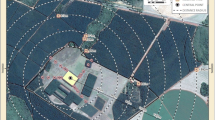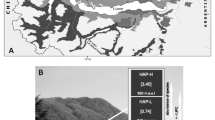Abstract
The first evidence of in situ F1 hybridisation between an introduced eucalypt plantation species, Eucalyptus nitens, and a native eucalypt species is presented. Open-pollinated seed was collected from a mature E. nitens trial and from the adjacent native species, E. ovata and E. viminalis on the island of Tasmania. Nearly 70 000 seedlings were grown to a size at which hybrids could be clearly distinguished from pure species seedlings on the basis of morphology and a nearly species-specific isozyme allele. Hybridisation was observed between E. nitens and E. ovata, but no hybrids involving E. viminalis were found. This pattern of hybridisation was consistent with the flowering time overlap between the E. ovata and E. nitens. Eucalyptus nitens progenies displayed a low and relatively homogeneous level of hybridisation, averaging 0.15% per tree. In comparison, the proportion of hybrids obtained from the adjacent E. ovata trees varied from 0.04 to 16% per tree. Whether progeny arising from such hybridisation will survive and grow in nature to allow for backcrossing and introgression of the exotic genes into the native population is not yet known.
Similar content being viewed by others
References
Anttila C.K., Daehler C.C., Rank N.E. and Strong D.R. 1998. Greater male fitness of a rare invader (Spartina alterniflora, Poaceae) threatens a common native (Spartina foliosa) with hybridisation. Am. J. Bot. 85: 1597–1601.
Arnold M.L. 1992. Natural hybridisation as an evolutionary process. Annu. Rev. Ecol. Syst. 23: 237–261.
Arnold M.L. and Hodges S.A. 1995. The fitness of hybrids-reply. Trends Ecol. Evol. 10: 289–289.
Arnold M.L., Bulger M.R., Burke J.M., Hempel A.L. and Williams J.H. 1999. Natural hybridisation: How low can you go and still be important? Ecology 80: 371–381.
Brooker M.I.H. 2000. A new classification of the genus Eucalyptus L'Her. (Myrtaceae). Aust. Syst. Bot. 13: 79–148.
Byrne M. and Macdonald B. 2000. Phylogeography and conservation of three oil mallee taxa, Eucalyptus kochii ssp. kochii, ssp. plenissima and E. horistes. Aust. J. Bot 48: 305–313.
Cagelli L. and Lefevre F. 1995. The conservation of Populus nigra L. and gene flow with cultivated poplars in Europe. For. Gen. 2: 135–144.
Cook I.O. and Ladiges P.Y. 1998. Isozyme variation in Eucalyptus nitens and E denticulata. Aust. J. Bot. 46: 35–44.
Day T. and Schluter D. 1995. The fitness of hybrids. Trends Ecol. Evol. 10: 288.
Ellis M.F., Sedgley M. and Gardner J.A. 1991. Interspecific pollen-pistil interaction in Eucalyptus L'Hér. (Myrtaceae); the effect of taxonomic distance. Ann. Bot. 68: 185–194.
Ellstrand N.C. 1992. Gene flow by pollen: implications for plant conservation genetics. Oikos 63: 77–86.
Ellstrand N.C. and Hoffman C.A. 1990. Hybridisation as an avenue of escape for engineered genes. Bioscience 40: 438–442.
Environment Australia, http: / / www.biodiversity.environment.gov.au / plants / threaten / lists / esplists / sched1–ind.htm 2000. Endangered Species Protection Act 1992, Schedule 1–January 2000.
Gallo L.A., Marchelli P. and Breitembucher 1997. Morphological and allozymic evidence of natural hybridisation between two southern beeches (Nothofagus spp.) and its relation to heterozygosity and height growth. For. Gen. 4: 15–23.
Griffin A.R., Whitemen P., Rudge T., Burgess I.P. and Moncur M.W. 1993. Effect of paclobutrazol on flower-bud production and vegetative growth in two species of Eucalyptus. Can. J. For. Res. 23: 630–647.
Griffin A.R., Burgess I.P. and Wolf L. 1988. Patterns of natural and manipulated hybridisation in the genus Eucalyptus L'Héerit.-a review. Aust. J. Bot. 36: 41–66.
Hopper S.D. 1997. An Australian perspective on plant conservation biology in practice. In: Fiedler P.L. and Kareiva P.M. (eds), Conservation Biology for the Coming Decade. Chapman and Hall, New York, pp. 255–278.
James R.R., Difazio S.P., Brunner A.M. and Strauss S.H. 1998. Environmental effects of genetically engineered woody biomass crops. Biomass & Bioenergy 14: 403–414.
Levin D.A., Franciscoortega J. and Jansen R.K. 1996. Hybridisation and the extinction of rare plant species. Cons. Biol. 10: 10–16.
Lopez G.A., Potts B.M. and Tilyard P.A. 2000. F hybrid inviability in Eucalyptus: the case of E. ovata × E. globulus. Heredity 85: 242–250.
Mejnartowicz L. 1996. Cisovka-the relic population of Abies alba and its relationship to man-made Silver-Fir stands in Bialowieza primeval forest. Acta Soc. Bot. Pol. 65: 319–328.
Ministerial Council on Forestry, Fisheries and Agriculture 1997. Plantations for Australia: the 2020 Vision. no. 24 pp 88, Ministerial Council on Forestry, Fisheries and Agriculture.
Moncur M.W., Hand F.C. and Ramsden N.G. 1994. Environmental and cultural effects on flowering and seed production of plantation grown Eucalyptus nitens. Report for the Tasmanian Forest Research Council, Inc.. Division of Forestry, CSIRO Canberra.
Moran G.F. and Bell J.C. 1983. Eucalyptus. In: Tanksley S.D. and orton T.J. (eds), Isozymes in plant genetics and breeding. Elsevier, Amsterdam, pp. 423–441.
Moran G.F., Bell J.C. and Prober S. 1990. The utility of isozymes in the systematics of some Australian tree groups. Aust. J. Bot. 3: 47–57.
Pederick L.A. 1979. Natural variation in Shining Gum (Eucalyptus nitens). Aust. For. Res. 9: 41–63.
Potts B.M. and Reid J.B. 1988. Hybridisation as a dispersal mechanism. Evolution 42: 1245–1255.
Potts B.M. and Reid J.B. 1990. The evolutionary significance of hybridisation in Eucalyptus. Evolution 44: 2151–2152.
Potts B.M. and Wiltshire R.J.E. 1997. Eucalypt genetics and genecology. In: Williams J. and Woinarski J. (eds), Eucalypt ecology: individuals to ecosystems. Cambridge University Press, Cambridge, pp. 56–91.
Pryor L.D. 1976. Biology of eucalypts. Edward Arnold, London.
Raybould A.F. and Gray A.J. 1994. Will hybrids of genetically modified crops invade natural communities? Trends Ecol. Evol. 9: 85–89.
Rhymer J.M. and Simberloff D. 1996. Extinction by hybridisation and introgression. Ann. Rev. Ecol. and Syst. 27: 83–109.
Smith R.L. and Sytsma K.J. 1990. Evolution of Populus nigra (sect. Aigeiros): introgressive hybridisation and the chloroplast contribution of Populus alba (sect. Populus). Am. J. Bot. 77: 1176–1187.
Strauss S.H., Knowe S.A. and Jenkins J. 1997. Benefits and risk of transgenic, Roundup Ready® cottonwoods. J. For. 95: 12–19.
Tibbits W.N. 1988. Germination and morphology of progeny from controlled pollinations of Eucalyptus nitens (Deane & Maiden) Maiden. Aust. J. Bot. 36: 677–691.
Tibbits W.N., Boomsma D.B. and Jarvis S. 1997. Distribution, biology, genetics, and improvement programs for Eucalyptus globulus and E. nitens around the world. In: White T., Huber D. and Powell G. (eds), Proceedings of the 24th Biennial Southern Tree Improvement Conference, June 9–12 1997. Southern Tree Improvement Committee, Orlando, Florida pp. 1–15., pp. 1–15.
Wendel J.F. and Weeden N.F. 1989. Visualisation and interpretation of plant isozymes. In: Soltis D.E. and Soltis P.A. (eds), Isozymes in plant biology. Chapman and Hall, London pp. 5–45., pp. 5–45.
Williams K.J. and Potts B.M. 1996. The natural distribution of Eucalyptus species in Tasmania. Tasforests 8: 39–136.
Author information
Authors and Affiliations
Corresponding author
Rights and permissions
About this article
Cite this article
Barbour, R.C., Potts, B.M., Vaillancourt, R.E. et al. Gene flow between introduced and native Eucalyptus species. New Forests 23, 177–191 (2002). https://doi.org/10.1023/A:1020389432492
Issue Date:
DOI: https://doi.org/10.1023/A:1020389432492




